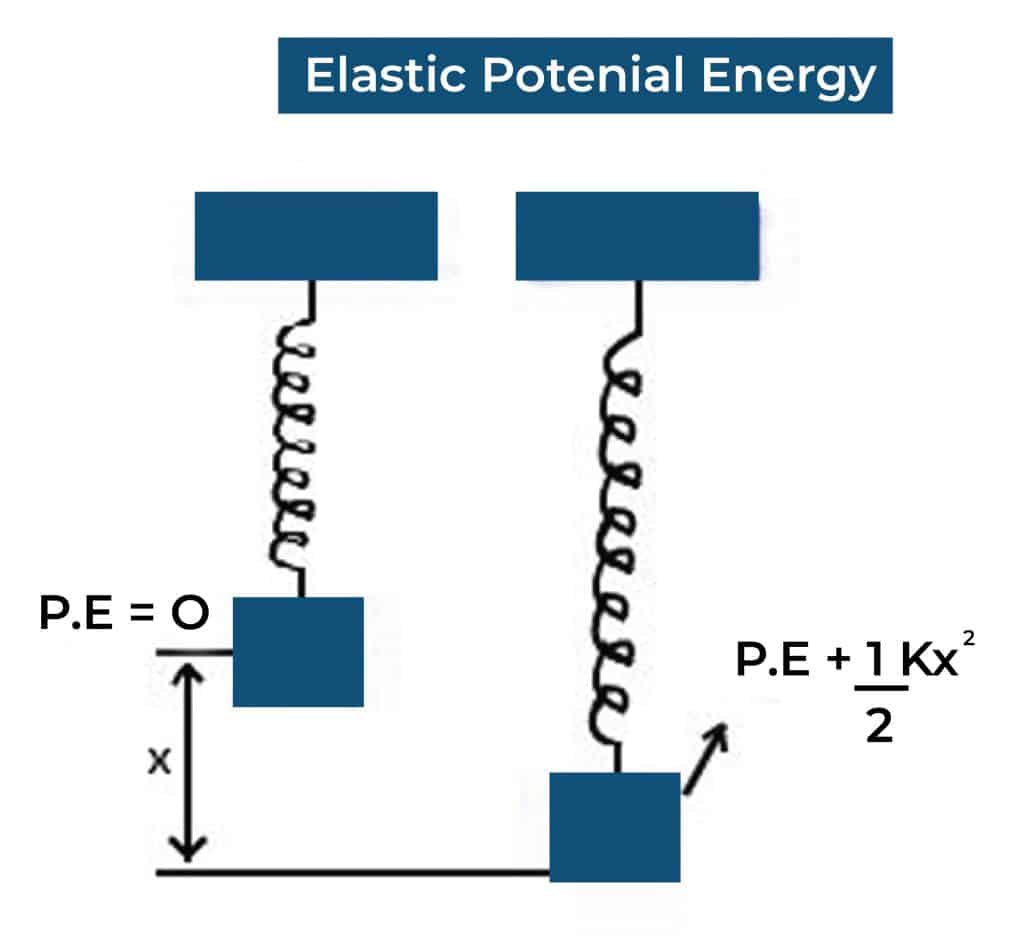Elastic Energy
Grade 6 Science Worksheets
Elastic energy is the potential energy stored in an elastic material when it is deformed under stress or strain. When a material is stretched or compressed, work is done on the material, and energy is stored in it as potential energy. This energy is released when the material returns to its original shape.
Table of Contents:
- Elastic Energy
- Elastic Potential Energy into Kinetic Energy
- Elastic Potential Energy Examples
- FAQs
Elastic Energy - Grade 6 Science Worksheet PDF
This is a free printable / downloadable PDF worksheet with practice problems and answers. You can also work on it online.
|
Untimed | |
Sign up with your email ID to access this free worksheet.
"We really love eTutorWorld!"
"We really love etutorworld!. Anand S and Pooja are excellent math teachers and are quick to respond with requests to tutor on any math topic!" - Kieran Y (via TrustSpot.io)
"My daughter gets distracted easily"
"My daughter gets distracted very easily and Ms. Medini and other teachers were patient with her and redirected her back to the courses.
With the help of Etutorworld, my daughter has been now selected in the Gifted and Talented Program for the school district"
- Nivea Sharma (via TrustSpot.io)
Elastic energy is a form of potential energy, as it is stored energy that has the potential to do work. It can be converted to other forms of energy, such as kinetic energy, when the object returns to its original shape.

There are two types of Elastic Energy:
1. Strain Energy: This type of elastic energy is stored in an object when it is deformed due to the strain applied to it. It is proportional to the amount of deformation and the stiffness of the material.
2. Elastic Potential Energy: This type of elastic energy is stored in an object when it is compressed or stretched. It is proportional to the amount of deformation and the force applied to the material.
Elastic Potential Energy into Kinetic Energy
Elastic potential energy can be transformed into kinetic energy when an elastic object is released from its deformed state and allowed to return to its original shape. The energy stored in the object is then converted into kinetic energy as it moves. The formula for the transformation of elastic potential energy into kinetic energy can be expressed as:
1/2 * k * x^2 = 1/2 * m * v^2
where:
k is the spring constant of the elastic material (a measure of its stiffness)
x is the displacement of the object from its equilibrium position (the amount by which the object was stretched or compressed)
m is the mass of the object
v is the velocity of the object as it moves.
The left-hand side of the equation represents the elastic potential energy stored in the object, while the right-hand side represents the kinetic energy of the moving object.
This equation is derived from the conservation of mechanical energy, which states that the total energy in a closed system (in this case, the object and the spring) remains constant, and is transformed between potential and kinetic energy.
“There have been times when we booked them last minute, but the teachers have been extremely well-prepared and the help desk at etutorworld is very prompt.
Our kid is doing much better with a higher score.”
6th Grade Tutoring
eTutorWorld offers Personalized Online Tutoring for Math, Science, English, and Standardised Tests.
Our Tutoring Packs start at just under $22.49 per hour, and come with a moneyback guarantee.
Schedule a FREE Trial Session, and experience quality tutoring for yourself. (No credit card required.)
Elastic Potential Energy Examples
1. A stretched rubber band: When a rubber band is stretched, it stores elastic potential energy. This energy is released when the rubber band is released, and it snaps back to its original shape.
2. A compressed spring: When a spring is compressed, it stores elastic potential energy. This energy is released when the spring is released, and it returns to its original shape.
3. A bow and arrow: When an archer pulls back on a bowstring, the bowstring stores elastic potential energy. This energy is released when the archer releases the arrow, and the bowstring snaps back to its original position.
4. A trampoline: When someone jumps on a trampoline, the trampoline mat stretches and stores elastic potential energy. This energy is released when the person bounces back up, and the trampoline mat returns to its original shape.
5. A diving board: When someone jumps on a diving board, the diving board bends and stores elastic potential energy. This energy is released when the person bounces back up, and the diving board returns to its original shape.
In each of these examples, the object stores elastic potential energy when it is deformed due to an applied force or displacement. The energy is released when the object returns to its original shape, resulting in a movement or change in position.
Do You Stack Up Against the Best?
If you have 30 minutes, try our free diagnostics test and assess your skills.
Elastic Energy FAQS
What is elastic energy?
Elastic energy is the potential energy stored in an elastic material when it is deformed under stress or strain. When a material is stretched or compressed, work is done on the material, and energy is stored in it as potential energy.
What are the types of elastic energy?
The two main types of elastic energy are strain energy and elastic potential energy. Strain energy is stored in an object when it is deformed due to the strain applied to it, while elastic potential energy is stored in an object when it is compressed or stretched.
What is the formula for elastic potential energy?
The formula for elastic potential energy is: E = 1/2 * k * x^2, where E is the elastic potential energy, k is the spring constant of the elastic material, and x is the displacement of the object from its equilibrium position.
How is elastic potential energy transformed into kinetic energy?
Elastic potential energy can be transformed into kinetic energy when an elastic object is released from its deformed state and allowed to return to its original shape. The energy stored in the object is then converted into kinetic energy as it moves.
What are some examples of elastic potential energy?
Some examples of elastic potential energy include a stretched rubber band, a compressed spring, a bow and arrow, a trampoline, and a diving board. In each of these examples, an object stores elastic potential energy when it is deformed due to an applied force or displacement.

Kathleen Currence is one of the founders of eTutorWorld. Previously a middle school principal in Kansas City School District, she has an MA in Education from the University of Dayton, Ohio. She is a prolific writer, and likes to explain Science topics in student-friendly language. LinkedIn Profile
Affordable Tutoring Now Starts at Just $22.49
eTutorWorld offers affordable one-on-one live tutoring over the web for Grades K-12. We are also a leading provider of Test Prep help for Standardized Tests (SCAT, CogAT, MAP, SSAT, SAT, ACT, ISEE, and AP).
What makes eTutorWorld stand apart are: flexibility in lesson scheduling, quality of hand-picked tutors, assignment of tutors based on academic counseling and diagnostic tests of each student, and our 100% money-back guarantee.
Whether you have never tried personalized online tutoring before or are looking for better tutors and flexibility at an affordable price point, schedule a FREE TRIAL Session with us today.
*There is no purchase obligation or credit card requirement
Grade 6 Science Worksheets
- Inquiry process
- Nature of Science
- Scientific Inquiry
- Inquiry, Analysis and Problem Solving
- Ethical Practices
- Science and Society
- Biotic and Abiotic Factors
- Impact of Organisms
- Adaptation
- Spheres of Earth
- Natural Resources
- Environmental Issues
- Conservation of Earth
- Understanding Technology
- Abilities To Do Technological Design
- Structure of Earth
- Solar System
- Rocks and Fossils
- Earth Systems
- Plate Tectonics
- Evolution
- Magnetic Field of Earth
- Geologic Time
- Materials and Processes That Shape a Planet
- Astronomy
- Ecology
- Energy
- Kinetic and Potential Energy
- Energy Transfer
- Matter and its Structure
- States of Matter
- Physical and Chemical Changes
- Force and Motion
- Electricity and Magnetism
- Wave Interactions
- Sound
- Light
- Introduction to Life Science
- The Origin & History of Life On Earth
- Plant and Animal Cells
- Parts of a Cell
- The Cell Cycle
- How Living Organisms Get Energy
- Classification of Organisms
- How Plants Grow & Reproduce
- The Human Respiratory System
- The Human Cardiovascular System
- The Human Digestive System
- The Human Endocrine Systems
- The Human Nervous System
- The Human Muscular System
- The Human Skeletal System
IN THE NEWS

Our mission is to provide high quality online tutoring services, using state of the art Internet technology, to school students worldwide.
Online test prep and practice
SCAT
SSAT
ISEE
PSAT
SAT
ACT
AP Exam
Science Tutoring
Physics Tutoring
Chemistry Tutoring
Biology Tutoring
Math Tutoring
Pre-Algebra Tutoring
Algebra Tutoring
Pre Calculus Tutoring
Calculus Tutoring
Geometry Tutoring
Trigonometry Tutoring
Statistics Tutoring
Quick links
Free Worksheets
Fact sheet
Sales Partner Opportunities
Parents
Passive Fundraising
Virtual Fundraising
Our Expert Tutors
Safe and Secure Tutoring
Interactive Online Tutoring
After School Tutoring
Elementary School Tutoring
Middle School Tutoring
High School Tutoring
Home Work Help
Math Tutors New York City
Press
©2022 eTutorWorld Terms of use Privacy Policy Site by Little Red Bird
©2022 eTutorWorld
Terms of use
Privacy Policy
Site by Little Red Bird










